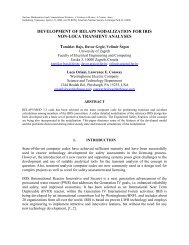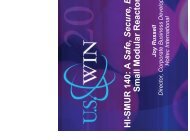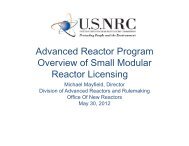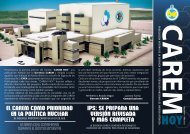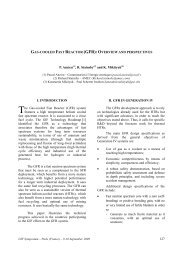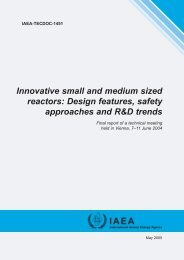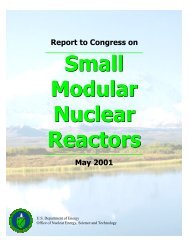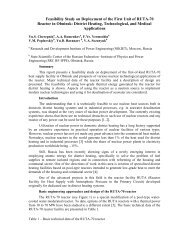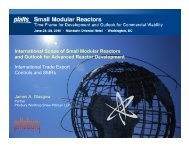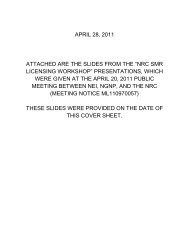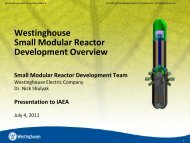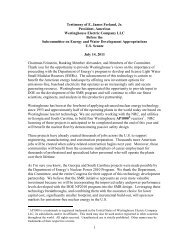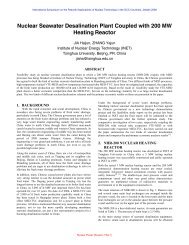subject: review of toshiba 4s sodium-cooled nuclear power reactor
subject: review of toshiba 4s sodium-cooled nuclear power reactor
subject: review of toshiba 4s sodium-cooled nuclear power reactor
Create successful ePaper yourself
Turn your PDF publications into a flip-book with our unique Google optimized e-Paper software.
Brian Hirsch, Development Director<br />
Rob Rosenfeld, Alaska Regional Director<br />
Jon Waterhouse, Solid Waste Program Manager<br />
Yukon River Inter-Tribal Watershed Council<br />
725 Christensen, Suite 3<br />
Anchorage, Alaska 99501<br />
December 11, 2006<br />
SUBJECT:<br />
REVIEW OF TOSHIBA 4S SODIUM-COOLED NUCLEAR POWER<br />
REACTOR PROPOSED FOR GALENA, ALASKA<br />
Dear Gentlemen:<br />
I <strong>review</strong>ed publicly available information on the Toshiba 4S <strong>sodium</strong>-<strong>cooled</strong> <strong>nuclear</strong> <strong>power</strong> <strong>reactor</strong> being<br />
considered for operation in Galena, Alaska. This <strong>review</strong> is necessarily limited in its scope because no<br />
Toshiba 4S <strong>reactor</strong> has ever operated any where on the planet and the company is still developing the<br />
detailed design package for this experimental <strong>reactor</strong>. The safety questions that I was unable to find<br />
answered in the publicly available information are described below.<br />
FIELD EXPERIMENT OF PROTOTYPE REACTOR DESIGN<br />
The publicly available information indicates that the Toshiba 4S <strong>reactor</strong> would be provided to Galena at<br />
an apparent bargain price:<br />
“Toshiba has approached the City with the <strong>of</strong>fer to provide the <strong>reactor</strong> and <strong>power</strong> plant at no<br />
capital cost so that the 4S can have a reference site and operation experience.” 1<br />
Just like Chuck Yeager did not have to buy a ticket for his X-1 flight in breaking the sound barrier and<br />
Alan Shepard did not have to buy a ticket for his Freedom 7 first US manned space flight, it is rare that<br />
people pay for prototypes. Once the bugs have been worked out and the risks reduced, companies then<br />
market production models to commercial customers.<br />
The proponents <strong>of</strong> the Toshiba 4S design (and it’s worth noting that this design is not the next<br />
evolutionary step from a Toshiba 1S, Toshiba 2S, and Toshiba 3S series <strong>of</strong> proven designs; this design<br />
currently exists only on paper and in cyberspace) want to skip some steps in the normal development<br />
process for new technology:<br />
“Toshiba currently is conducting engineering work to complete the <strong>reactor</strong> and plant designs.<br />
Therefore, if the first operational unit is installed at a site such as Galena it would be considered<br />
a “reference” rather than a “prototype” or “demonstration” plant. … The assumption that the<br />
4S would be a reference plant is <strong>subject</strong> to some question by U.S. National Laboratory staff.” 2<br />
1 U.S. Department <strong>of</strong> Energy, 2004. “Galena Electric Power – a Situational Analysis,” Draft Final Report. December<br />
15, page 7.<br />
2 U.S. Department <strong>of</strong> Energy, 2004. “Galena Electric Power – a Situational Analysis,” Draft Final Report. December<br />
15, page 32.<br />
Washington Office: 1707 H Street NW Suite 600 • Washington DC 20006-3919 • 202-223-6133 • FAX: 202-223-6162<br />
Cambridge Headquarters: Two Brattle Square • Cambridge MA 02238-9105 • 617-547-5552 • FAX: 617-864-9405<br />
California Office: 2397 Shattuck Avenue Suite 203 • Berkeley CA 94704-1567 • 510-843-1872 • FAX: 510-843-3785
December 11, 2006<br />
Page 2 <strong>of</strong> 6<br />
The US government is unlikely to permit an unproven design to move directly from foreign blueprints to<br />
American backyards, particularly without qualifications and conditions such as those acknowledged by<br />
the <strong>reactor</strong>’s proponents:<br />
“For a first-<strong>of</strong>-a-kind installation in Galena, licensing requirements may include extensive<br />
analysis <strong>of</strong> the <strong>reactor</strong> after a short run-time (i.e., 1 to 5 years). In this case the <strong>reactor</strong> would be<br />
changed out at that interval and returned to Toshiba for analysis.” 3<br />
Even if the US government allowed a foreign company to convert an American city into an experimental<br />
<strong>reactor</strong> laboratory, that government is likely to impose conditions to gauge how well the experiment is<br />
progressing. That American city might be inconvenienced by its <strong>power</strong> plant being unavailable during its<br />
Japanese “vacation.”<br />
SODIUM-COOLED REACTOR OPERATING EXPERIENCE<br />
The publicly available information on the Toshiba 4S <strong>sodium</strong>-<strong>cooled</strong> <strong>nuclear</strong> <strong>reactor</strong> – I find it curious<br />
that NONE <strong>of</strong> the 4S’s stands for <strong>sodium</strong> even though it’s the most distinguishing aspect <strong>of</strong> the <strong>reactor</strong>’s<br />
design – completely misrepresent actual operating experience worldwide with <strong>sodium</strong>-<strong>cooled</strong> <strong>reactor</strong>s.<br />
Consider these verbatim statements from two different documents:<br />
“Sodium <strong>cooled</strong> <strong>reactor</strong>s throughout the world have been run for thousands <strong>of</strong> hours without<br />
incidents involving the <strong>reactor</strong> core.” 4<br />
and<br />
“Liquid metal <strong>reactor</strong>s (LMRs) have been operated successfully worldwide and have been used in<br />
the United States at test facilities, with over 300 <strong>reactor</strong> years <strong>of</strong> operational experience.” 5<br />
The first statement is either horribly misinformed or an outright falsehood. The history <strong>of</strong> <strong>sodium</strong>-<strong>cooled</strong><br />
<strong>reactor</strong>s in the United States had very serious incidents involving the <strong>reactor</strong> core. For example, there<br />
were the following two events involving partial meltdown <strong>of</strong> the <strong>reactor</strong> cores <strong>of</strong> <strong>sodium</strong>-<strong>cooled</strong> <strong>reactor</strong>s:<br />
• In July 1959, the <strong>sodium</strong>-<strong>cooled</strong> <strong>nuclear</strong> <strong>reactor</strong> at the Santa Susana facility outside Los Angeles,<br />
California, experienced overheating causing damage to roughly one-third <strong>of</strong> the fuel elements in<br />
the <strong>reactor</strong> core. The design <strong>of</strong> this <strong>reactor</strong> was very similar to that proposed for Galena in that it<br />
also featured a low-pressure, pool-type, <strong>sodium</strong>-<strong>cooled</strong> <strong>reactor</strong> with a <strong>sodium</strong>/<strong>sodium</strong> heat<br />
exchanger and a secondary <strong>sodium</strong>/water steam generator. 6<br />
• In October 1966, the <strong>sodium</strong>-<strong>cooled</strong> <strong>nuclear</strong> <strong>reactor</strong> at the Enrico Fermi <strong>nuclear</strong> plant outside<br />
Detroit, Michigan experienced overheating causing damage to several fuel assemblies in the<br />
<strong>reactor</strong> core. 7<br />
It is true that both <strong>of</strong> these incidents involving <strong>reactor</strong> core damage at <strong>sodium</strong>-<strong>cooled</strong> <strong>reactor</strong>s occurred<br />
more than 40 years ago. But that distant past is explained in large part by proper context for the second<br />
misleading statement quoted above. That statement implies that <strong>sodium</strong>-<strong>cooled</strong> <strong>reactor</strong>s are tried and<br />
proven. The reality is that <strong>sodium</strong>-<strong>cooled</strong> <strong>reactor</strong>s are a tried and rejected technology. At the end <strong>of</strong> 2005,<br />
3 U.S. Department <strong>of</strong> Energy, 2004. “Galena Electric Power – a Situational Analysis,” Draft Final Report. December<br />
15, page 34.<br />
4 U.S. Department <strong>of</strong> Energy, 2004. “Galena Electric Power – a Situational Analysis,” Draft Final Report. December<br />
15, page 35.<br />
5 City <strong>of</strong> Galena, Alaska, 2006. “Overview <strong>of</strong> Galena’s Proposed Approach to Licensing a 4S Nuclear Reactor<br />
Based Power Generation Facility.” March 21, page 5.<br />
6 Atomics International, 1959. “SRE Fuel Element Damage: An Interim Report.” November 30.<br />
7 Power Reactor Development Company, 1968. “Report on the Fuel Melting Incident in the Enrico Fermi Atomic<br />
Power Plant on October 5, 1966.” December 15.
December 11, 2006<br />
Page 3 <strong>of</strong> 6<br />
there were 444 <strong>nuclear</strong> <strong>power</strong> <strong>reactor</strong>s operating worldwide. Only two (2) <strong>of</strong> these hundreds <strong>of</strong> <strong>reactor</strong>s<br />
were <strong>sodium</strong>-<strong>cooled</strong>. 8 History has repeatedly shown <strong>sodium</strong>-<strong>cooled</strong> <strong>reactor</strong>s to be unsafe, unreliable,<br />
and/or uneconomical. An abridged list <strong>of</strong> <strong>sodium</strong>-<strong>cooled</strong> <strong>reactor</strong>s permanently shutdown years before<br />
their projected ends <strong>of</strong> lifetime:<br />
Name Country Output Started Shutdown<br />
Creys-Malville France 1200 Mwe 01/1986 12/1998<br />
Aktau Kazakhstan 135 Mwe 07/1973 04/1999<br />
Dounreay United<br />
250 Mwe 08/1976 03/1994<br />
Kingdom<br />
EBR-II United States 20 Mwe 08/1964 09/1994<br />
Fermi United States 61 Mwe 08/1966 11/1972<br />
Hallam United States 75 Mwe 11/1963 09/1964<br />
Sodium-<strong>cooled</strong> <strong>nuclear</strong> <strong>reactor</strong>s may have compiled more than 300 years <strong>of</strong> operational experience, but<br />
that history has been so troubled that country after country abandoned the technology as unviable. More<br />
than 99.5 percent <strong>of</strong> the <strong>nuclear</strong> <strong>power</strong> <strong>reactor</strong>s operating in the world today are NOT <strong>sodium</strong>-<strong>cooled</strong>.<br />
There’s a reason for that – <strong>sodium</strong>-<strong>cooled</strong> <strong>reactor</strong> technology failed in the commercial marketplace.<br />
REACTIVITY CONTROL<br />
The Toshiba 4S design would produce energy from a sustained <strong>nuclear</strong> chain reaction within the <strong>reactor</strong><br />
core. The splitting, or fissioning, <strong>of</strong> atoms releases energy and also <strong>nuclear</strong> particles that can interact with<br />
other atoms to cause more splitting. “Reactivity control” is the term <strong>of</strong> art applied to the regulation <strong>of</strong> the<br />
rate <strong>of</strong> fissioning in the <strong>reactor</strong> core. According to the publicly available information, the Toshiba 4S<br />
<strong>reactor</strong> features:<br />
“A single control rod has absolute control on reactivity and <strong>power</strong>. … The core can be<br />
maintained in the cold shutdown condition with the control rod inserted. The control rod also<br />
scrams the <strong>reactor</strong> by either <strong>of</strong> two diverse actuators when rapid shutdown is required.” 9<br />
It’s highly questionable that a design with this feature can be licensed in the United States. In January<br />
1961, the withdrawal <strong>of</strong> a single control rod at the SL-1 <strong>nuclear</strong> <strong>reactor</strong> in Idaho resulted in an<br />
uncontrolled <strong>nuclear</strong> reaction and steam explosion that killed every single person at the plant site. 10 One<br />
<strong>of</strong> the many lessons from this tragic accident was to NOT design and operate production <strong>reactor</strong>s such<br />
that a single control rod is capable <strong>of</strong> so much reactivity control. When this lesson is properly applied, a<br />
single operator error or equipment malfunction cannot trigger an uncontrolled <strong>nuclear</strong> chain reaction.<br />
The Toshiba 4S design also features fine-tuning reactivity control:<br />
“A cylindrical steel reflector shield rising from the bottom [<strong>of</strong> the <strong>reactor</strong> vessel] at a rate <strong>of</strong><br />
around 5 cm/yr by means <strong>of</strong> an electromagnetic drive mechanism maintains the proper reaction<br />
rate by reflecting neutrons back into the core. The reflectors are moving upward slowly in order<br />
to compensate the reactivity loss during 30 years burn-up.” 11<br />
and<br />
8 American Nuclear Society, 2006. “World List <strong>of</strong> Nuclear Power Plants.” Nuclear News. March, page 62.<br />
9 City <strong>of</strong> Galena, Alaska, 2006. “Overview <strong>of</strong> Galena’s Proposed Approach to Licensing a 4S Nuclear Reactor<br />
Based Power Generation Facility.” March 21, page 18.<br />
10 United States Atomic Energy Commission, 1962. “IDO Report on the Nuclear Incident at the SL-1 Reactor<br />
January 3, 1961 at the National Reactor Testing Station,” January.<br />
11 U.S. Department <strong>of</strong> Energy, 2004. “Galena Electric Power – a Situational Analysis,” Draft Final Report.<br />
December 15, page 33.
December 11, 2006<br />
Page 4 <strong>of</strong> 6<br />
“The radial reflectors are movable and creep upward slowly during the service life <strong>of</strong> the core to<br />
maintain neutron flux and <strong>power</strong> levels. In case <strong>of</strong> electrical <strong>power</strong> loss or failure <strong>of</strong> the reflector<br />
drive, the assembly is designed to fall to the bottom <strong>of</strong> the core. Reflector bottoming will reduce<br />
reactivity and thus slow or stop the <strong>nuclear</strong> reaction depending on the operational age <strong>of</strong> the<br />
core.” 12<br />
The Toshiba 4S design is so conceptual at this stage that it is impossible to assess whether the reflector(s)<br />
could be mis-positioned or could malfunction to get higher than desired. The conceptual design refers to<br />
the reactivity control provided by negative temperature feedback (i.e., as fuel temperature rises, “brakes”<br />
are inherently applied on the <strong>nuclear</strong> chain reaction rate), but nothing in the publicly available information<br />
addressed what would happen if the reflector(s) moved to their vertical limit.<br />
FLAW-FREE OPERATION EXPECTATION<br />
The Toshiba “4S design introduces a small liquid metal <strong>nuclear</strong> <strong>reactor</strong> to the commercial <strong>power</strong> industry<br />
in the United States.” 13 As described in the Sodium-Cooled Reactor Operating Experience section, the<br />
worldwide experience with liquid metal <strong>nuclear</strong> <strong>reactor</strong>s – regardless <strong>of</strong> size – contradicts an assumption<br />
<strong>of</strong> flaw-free operation. Yet such an unfounded, unjustified assumption is part <strong>of</strong> the marketing campaign:<br />
“In all cases, the <strong>nuclear</strong> system will provide the lowest cost <strong>power</strong> to the consumer. … The<br />
economic analysis reveals that the 4S option will provide the lowest cost <strong>power</strong> if the assumptions<br />
hold. … If this technology is successfully deployed in Galena, its economic viability in other<br />
Alaska villages and elsewhere depends on the actual life cycle costs yet to be quantified.” 14<br />
and<br />
“Annual supplies and expenses are in addition to labor. Toshiba estimates about $1 million for<br />
this line item for their 50-MW plant. Since the <strong>reactor</strong> is sealed these expenses probably relate<br />
almost exclusively to the steam piping and turbine/generator systems. … Lacking specific data on<br />
this point, we have assumed that annual supplies and expenses are one-half the amount estimated<br />
by Toshiba for the 50-MW design.” 15<br />
Many things can go wrong, yet the feasibility studies ignore rather than discount this possibility. The cost<br />
and impact <strong>of</strong> things going wrong can be extremely significant. For example, consider this feature <strong>of</strong> the<br />
Toshiba <strong>4s</strong> design:<br />
“There is no design capability to open the <strong>reactor</strong> vessel, for any purpose other than at the<br />
factory.” 16<br />
The history <strong>of</strong> <strong>nuclear</strong> <strong>power</strong> is filled with “surprises” that required retr<strong>of</strong>itting to correct. Many <strong>of</strong> these<br />
“surprises” involved design errors or material degradation inside the <strong>reactor</strong> vessel. A few examples:<br />
• Turbulent coolant flows inside the fuel assemblies in <strong>reactor</strong> cores <strong>of</strong> boiling water <strong>reactor</strong>s<br />
necessitated the plugging <strong>of</strong> existing bypass flow paths in the lower core plates and the drilling <strong>of</strong><br />
new holes for bypass flow paths. 17<br />
12 City <strong>of</strong> Galena, Alaska, 2006. “Overview <strong>of</strong> Galena’s Proposed Approach to Licensing a 4S Nuclear Reactor<br />
Based Power Generation Facility.” March 21, page 18.<br />
13 City <strong>of</strong> Galena, Alaska, 2006. “Overview <strong>of</strong> Galena’s Proposed Approach to Licensing a 4S Nuclear Reactor<br />
Based Power Generation Facility.” March 21, page 5.<br />
14 U.S. Department <strong>of</strong> Energy, 2004. “Galena Electric Power – a Situational Analysis,” Draft Final Report.<br />
December 15, page 13.<br />
15 U.S. Department <strong>of</strong> Energy, 2004. “Galena Electric Power – a Situational Analysis,” Draft Final Report.<br />
December 15, page 64.<br />
16 U.S. Department <strong>of</strong> Energy, 2004. “Galena Electric Power – a Situational Analysis,” Draft Final Report.<br />
December 15, page 33.
December 11, 2006<br />
Page 5 <strong>of</strong> 6<br />
• Unexpected thermal stresses caused cracking and failure <strong>of</strong> the hold-down brackets for the nonmoving,<br />
non-mechanical jet pumps inside the <strong>reactor</strong> vessel <strong>of</strong> boiling water <strong>reactor</strong>s prompting<br />
inspections and replacements. 18<br />
• Unanticipated intra-granular stress corrosion cracking degraded the horizontal welds holding the<br />
core shrouds inside the <strong>reactor</strong> vessels <strong>of</strong> boiling water <strong>reactor</strong>s together and necessitating<br />
repairs. 19<br />
Each <strong>of</strong> these, and many similar, “surprises” required costly and time-consuming repairs – repairs that<br />
were conducted by opening the <strong>reactor</strong> vessel at the plants and performing repairs in the field. Obviously,<br />
comparable problems within the Toshiba 4S <strong>reactor</strong> vessel will be complicated if their repair requires the<br />
thing to be dug up and shipped back to the factory.<br />
The Toshiba 4S design is far from tried and true, yet its 30-year life at Galena relies on the extremely<br />
uncertain – and most likely false – assumption that the longstanding string <strong>of</strong> <strong>nuclear</strong> <strong>power</strong> “surprises”<br />
will magically end.<br />
BLACKSTART CAPABILITY<br />
There are 104 <strong>nuclear</strong> <strong>power</strong> <strong>reactor</strong>s currently licensed by the Nuclear Regulatory Commission to<br />
operate in the United States. Among the many things they have in common is the lack <strong>of</strong> blackstart<br />
capability. While each <strong>of</strong> these <strong>nuclear</strong> <strong>power</strong> <strong>reactor</strong>s is at a plant that generates electricity, NONE can<br />
startup without the <strong>power</strong> provided by the electrical grid. The <strong>nuclear</strong> <strong>power</strong> <strong>reactor</strong>s have onsite<br />
emergency diesel generators to provide backup <strong>power</strong> in event the electrical grid is unavailable, but the<br />
output <strong>of</strong> the diesel generators is limited to the safety equipment needed to protect the <strong>reactor</strong> cores from<br />
damage. The emergency diesel generators cannot also <strong>power</strong> the equipment needed to startup the <strong>nuclear</strong><br />
<strong>reactor</strong>s.<br />
These US <strong>nuclear</strong> <strong>power</strong> <strong>reactor</strong>s are like gasoline-<strong>power</strong>ed motor vehicles with automatic transmissions.<br />
When the gasoline engine is running, it makes enough <strong>power</strong> to move the vehicle while also generating<br />
electrical <strong>power</strong> for the radio and other equipment. But these vehicles need <strong>power</strong> from a battery to start<br />
up the gasoline engine, just as US <strong>nuclear</strong> plants need <strong>power</strong> from an electrical grid to start up the <strong>nuclear</strong><br />
<strong>reactor</strong>s.<br />
Galena has no connection to an outside <strong>power</strong> grid. 20 The publicly available information does not<br />
indicate whether the Toshiba 4S design has blackstart capability. The publicly available information does<br />
imply the need for electrical <strong>power</strong> to startup the Toshiba 4S <strong>reactor</strong>. For example:<br />
“Sodium receiving and transfer subsystems consist <strong>of</strong> equipment and piping to melt the contents<br />
<strong>of</strong> <strong>sodium</strong> drums and transfer the molten <strong>sodium</strong> to the respective heat transfer systems. The<br />
primary <strong>sodium</strong> process subsystem provides purification <strong>of</strong> <strong>sodium</strong> contained in the <strong>reactor</strong><br />
vessel. It also provides the capability to transfer and purify fresh <strong>sodium</strong> prior to plant start up.”<br />
21<br />
17 United States Nuclear Regulatory Commission, 1976. “Safety Evaluation Report on the Reactor Modification to<br />
Eliminate Significant In-Core Vibration in Browns Ferry Unit 1 and Unit 2.” March 3.<br />
18 United States Nuclear Regulatory Commission, 1980. “BWR Jet Pump Assembly Failure.” April 4.<br />
19 United States Nuclear Regulatory Commission, 1993. “Operating Reactors Events Briefing 93-34.” September 8.<br />
20 City <strong>of</strong> Galena, Alaska, 2006. “Overview <strong>of</strong> Galena’s Proposed Approach to Licensing a 4S Nuclear Reactor<br />
Based Power Generation Facility.” March 21, page 3.<br />
21 City <strong>of</strong> Galena, Alaska, 2006. “Overview <strong>of</strong> Galena’s Proposed Approach to Licensing a 4S Nuclear Reactor<br />
Based Power Generation Facility.” March 21, page 20.
December 11, 2006<br />
Page 6 <strong>of</strong> 6<br />
The diesel generators which the Toshiba 4S <strong>reactor</strong> would replace, have blackstart capability. The diesel<br />
generators do not require a backup <strong>nuclear</strong> <strong>reactor</strong> to enable them to startup. But the <strong>nuclear</strong> <strong>reactor</strong> may<br />
require backup diesel generators, or other means, to enable them to startup. It’s not apparent that the cost<br />
<strong>of</strong> providing blackstart capability was factored into the economic analysis <strong>of</strong> the “free” <strong>reactor</strong>.<br />
CONCLUSION<br />
Very little detailed information is publicly available on the experimental Toshiba 4S <strong>sodium</strong>-<strong>cooled</strong><br />
<strong>nuclear</strong> <strong>power</strong> <strong>reactor</strong> design at this time. No <strong>reactor</strong> like it has ever operated and the company still has<br />
considerable homework left to do on the <strong>reactor</strong>’s engineering. From the information that is publicly<br />
available, it appears that operation <strong>of</strong> the experimental Toshiba 4S <strong>sodium</strong>-<strong>cooled</strong> <strong>nuclear</strong> <strong>power</strong> <strong>reactor</strong><br />
would have to totally contradict more than four decades <strong>of</strong> actual experience for it to pose minimal risk to<br />
the community. While “perfect operation” <strong>of</strong> the first unit <strong>of</strong>f the assembly line is theoretically possible,<br />
no reasonable person would take that bet.<br />
Sincerely,<br />
David Lochbaum<br />
Director, Nuclear Safety Project<br />
Washington Officer



